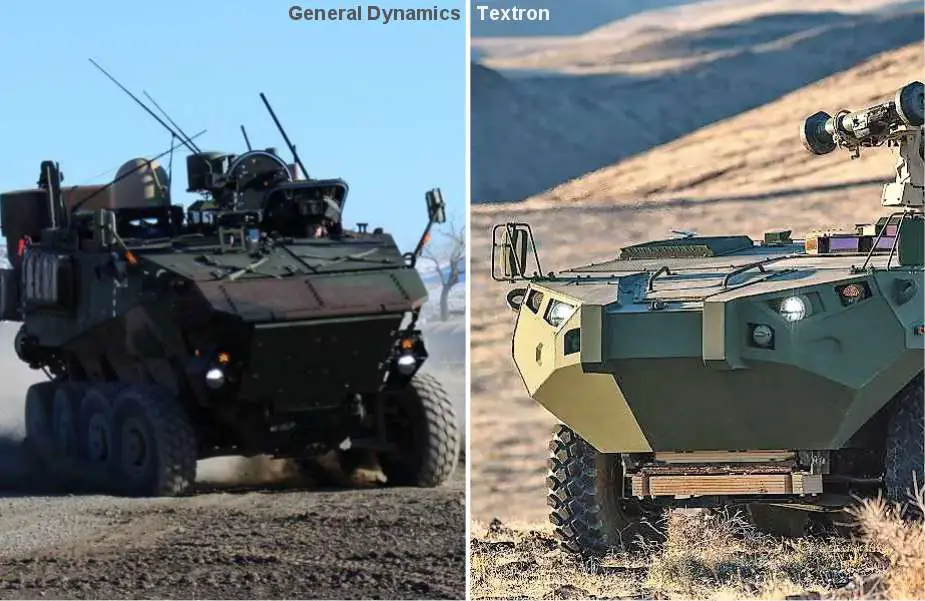On March 6, 2024, the US Marine Corps (USMC) confirmed the selection of General Dynamics Land Systems and Textron Systems for the task of designing, developing, and manufacturing a prototype for the Advanced Reconnaissance Vehicle 30mm Autocannon (ARV-30). This collaboration is scheduled over a two-year term, focusing on establishing a new combat vehicle to enhance the mobility and firepower of the Marines according to predefined requirements.
Follow Army Recognition on Google News at this link

The US Marine Corps is setting the stage for the incoming testing of ARV-30 prototypes developed by General Dynamics and Textron. (Picture source: GDLS and Textron)
The Army Contracting Command - Detroit Arsenal has awarded a contract action to General Dynamics Land Systems Inc., amounting to $10,926,309. This contract, categorized as cost plus fixed fee, is intended for the design of an ARV Medium Caliber Autocannon Prototype Vehicle, supporting the Program Manager Light Armored Vehicles' goal to create a prototype vehicle furnished with a 30mm gun. Scheduled for completion in Sterling Heights, Michigan, by September 24, 2024, the project has already had $5,452,228 obligated from the fiscal 2024 Marine Corps funds dedicated to research, development, test, and evaluation.
In a parallel arrangement, Textron Systems Corporation has been awarded a contract valued at $11,808,000 for the design of a similar prototype vehicle. This contract aligns with the same objectives set for General Dynamics, focusing on the development of a prototype featuring a 30mm gun. The work, expected to be carried out in Hunt Valley, Maryland, shares the completion date with the General Dynamics project, with $5,892,192 already obligated from the same Marine Corps fiscal 2024 funds.
The ARV-30 is designed to enhance the current capabilities of the USMC, in line with the Marine Corps’ specifications for Force Design 2030. The development criteria for the ARV emphasize mobility, connectivity, transportability, defense, and firepower, aimed at addressing contemporary and future threats. This vehicle is part of the Marine Corps’ broader initiative to introduce a new family of vehicles to support mobile reconnaissance missions and replace the existing fleet of Light Armored Vehicles (LAV-25) armed with a 25mm gun.
In a May 2019 briefing, the Marine Corps provided details on the required operational capabilities for the Advanced Reconnaissance Vehicle (ARV). These requirements include an automatic medium-caliber cannon for direct fire, and anti-armor capabilities to address nearby heavy armor threats. The vehicle is also expected to be equipped with precision-guided munitions to engage threats outside of conventional ranges. For increased versatility, the ARV should support unmanned systems capable of executing a range of functions through swarm capabilities.
Additionally, the inclusion of advanced and networked electronic warfare tools is anticipated, alongside a contemporary command-and-control suite enhanced with a full set of sensors. The ARV is also expected to support integrated unmanned aerial and ground systems for deployment directly from the vehicle. Vehicle protection should include both active and passive measures to defend against various threats. Lastly, the ARV should maintain efficient mobility for cross-country travel, on-road performance, and the ability to conduct operations from shore to shore.
The initiative for the ARV, initially conceived to enhance the operational capabilities of Light Armored Reconnaissance (LAR) Battalions, aligns with the broader missions of reconnaissance, surveillance, and security operations. These battalions are also tasked with conducting offensive, defensive, and deceptive maneuvers to support the strategic objectives of the Marine Division.
Steve Myers, Program Manager for Light Armored Vehicles, notes that the ARV-30 intends to incorporate the turret and weapon system from the ACV-30, aiming to improve troop capacity and payload efficiency while maintaining crew safety. This integration is expected to allow for better target engagement capabilities by the Marines.
With an anticipated procurement of approximately 500 ARVs, slated for delivery between 2026 and 2032, this program represents a significant update to the Marine Corps’ reconnaissance and combat capabilities. The expected financial commitment for this program ranges between US$1.8 billion and $6.8 billion.















